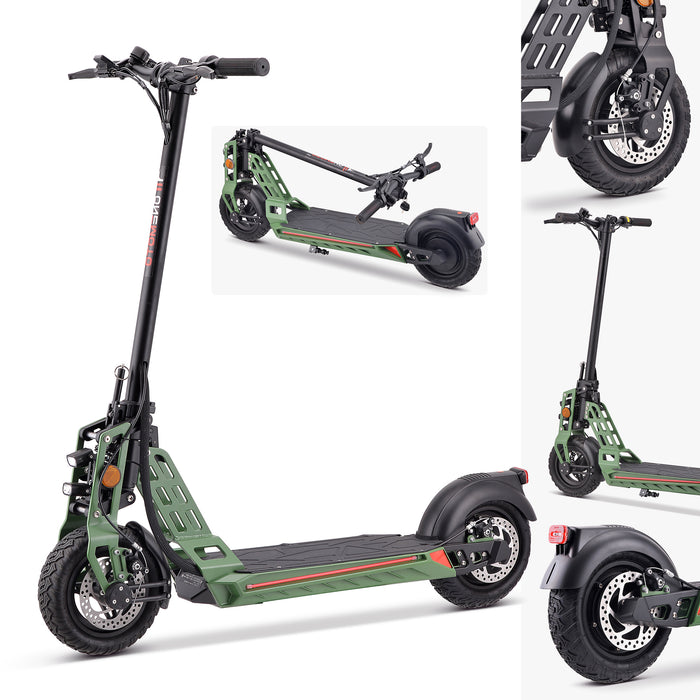
Navigating the choice between electric scooters and bicycles for urban commuting involves balancing factors like cost, convenience, and environmental impact.
This article breaks down the essentials, helping you weigh the benefits of each mode to find the best fit for your city life and commuting needs.
Whether you lean towards the swift efficiency of scooters or the health benefits of cycling, getting informed is your first step to a better commute.
Cost: Electric Scooters vs. Bicycles, What's Lighter on the Wallet?
Initial Investment: Sticker Shock vs. Budget-Friendly
Let's talk money, because whether you're saving for that dream vacation or just trying to keep your budget on track, what you spend on commuting matters.
Initially, electric scooters might make your bank account do a double-take—they're typically pricier upfront than bicycles.
But there's more to the story than just the initial sticker price.
Maintenance and Operational Costs: A Closer Look
While bicycles are generally cheaper at the start, they can have you visiting the repair shop more often than you'd like, especially if you're really racking up those miles.
On the flip side, electric scooters tend to have a higher initial cost but don't be fooled; they're not just a drain on your savings.
The ongoing maintenance for scooters is generally lower than for bicycles.
Think fewer flat tires and less wear and tear on the chain and gears—because, well, scooters don't have them.
The Energy Equation: Electric vs. Manual
And when it comes to the energy to keep them going, electricity for scooters can be kinder to your wallet than you might expect, especially compared to the cost of new bike parts and tune-ups.
This section helps readers understand not just the upfront costs but also what they might expect to spend over time, providing a comprehensive look at the financial considerations for both modes of transportation.
| Category | Electric Scooters | Bicycles |
|---|---|---|
| Initial Cost | Higher | Lower |
| Maintenance | Lower | Higher |
| Operational Expenses | Electricity Costs | Parts & Tune-ups |
| Long-Term Cost-Effectiveness | Depends on Usage | Depends on Maintenance |
Environmental Impact: Going Green on Two Wheels
Carbon Footprint: The Electric vs. Pedal Debate
If you're like me and trying to make choices that are a little kinder to our planet, you're probably wondering which option leaves a smaller carbon footprint.
Both electric scooters and bicycles are stars of the show here, cutting down on emissions by a ton compared to cars.
But let's dig a bit deeper.
Eco-Friendliness of Operation: Zero Emissions vs. Charged Rides
Bicycles are about as green as you can get. They run on good old-fashioned pedal power, which means zero emissions.
Plus, you're getting a workout, so it's a win-win.
On the flip side, electric scooters need to be charged, and depending on where you live, that electricity might not come from the greenest of sources.
But, they're still way ahead of cars when it comes to being eco-friendly.
Material Sustainability: The Lifecycle of Your Ride
Now, about those materials... Electric scooters and bicycles both use a mix, but the batteries in scooters can be a bit of an environmental headache when it's time to say goodbye.
The good news?
Recycling tech is catching up fast, making scooters a greener option every day.
Speed and Convenience: Zipping Through the City
The Need for Speed: Electric Scooters
Now, let's get to the fun part—speed and convenience. If you've got a need for speed, or just really enjoy hitting the snooze button one too many times, how quickly can you get from A to B?
Electric scooters are like the city slickers of commuting.
They zip through traffic, have a pretty decent top speed, and you don't show up to your destination looking like you just finished a marathon.
Perfect for those of us who value a few extra minutes of sleep.
Pacing and Exercise: The Bicycle Advantage
Bicycles, on the other hand, give you the flexibility of pacing yourself.
Want a leisurely ride?
You got it. Feel like breaking a sweat and pushing your limits?
Go for it. Plus, bicycles offer a level of exercise that scooters can't match, making them a fantastic choice for mixing fitness with commuting.
Navigating Urban Obstacles: Weather, Terrain, and Distance
Weather, terrain, and distance play a big role in which option is more convenient.
Electric scooters might struggle with steep hills or long distances without a charge, while bicycles can be a bit of a hassle in the rain or snow.
| Factor | Electric Scooters | Bicycles |
|---|---|---|
| Top Speed | Moderate to High | Varies by Effort |
| Convenience | High (Foldable, Light) | Moderate (Storage, Portability) |
| Terrain Adaptability | Limited by Battery/Design | High (Gears, Design) |
| Weather Adaptability | Varies (Slippery When Wet) | Varies (Equipment Dependent) |
Infrastructure: Paving the Way for Urban Commuters
The Rise of Bike Lanes
Ever notice those bike lanes popping up everywhere? Cities are catching on to the commuting revolution.
But whether you're team electric scooter or team bicycle, the infrastructure plays a big role in how enjoyable your commute is.
Parking and Charging: Convenience on the Go
Bike lanes are a win-win, offering a safer route for both scooters and bicycles.
However, parking an electric scooter can be as easy as folding it up and taking it with you, dodging the need for bike racks or lockups.
Charging stations for scooters are becoming more common, but they're not everywhere yet.
Bicycles don't need charging, of course, but finding a secure spot to lock up in a city can sometimes feel like joining a high-stakes game of Tetris.
Health Benefits: More Than Just Moving
The Workout Advantage of Bicycles
Switching gears to health, it's clear that bicycles have the upper hand when it comes to a workout.
Cycling is fantastic for your heart, muscles, and mind, providing a stress-releasing exercise that can fit seamlessly into your daily routine.
Mental Health and Core Engagement on Scooters
Electric scooters, while not providing the same level of physical exercise, can offer mental health benefits.
The convenience and ease of scooting can reduce commuting stress and add a little fun to your day.
Plus, standing and balancing on a scooter does engage some core muscles, so it's not a complete fitness write-off.
Safety: Keeping It Wheels Down
Visibility and Navigation: Essential for Urban Commuting
When it comes to safety, visibility, and knowing how to navigate the urban jungle are key.
Both electric scooters and bicycles share similar risks and rewards.
High-visibility gear and helmets are must-haves, regardless of your ride choice.
Handling and Stability: Scooters vs. Bicycles
Electric scooters can be a bit more nimble, allowing for quick maneuvers.
However, their smaller wheels might not handle potholes or rough roads as well as bicycles.
Bicycles, with their larger frame and wheels, can offer a bit more stability, especially on uneven surfaces.
Regulations: Navigating the Legal Landscape
Understanding the Rules
Alright, let's get down to the nitty-gritty—regulations.
It's not the most thrilling topic, but hey, knowing what you're allowed to do (and where) can save you a headache down the line.
The Gray Areas of Commuting Laws
Electric scooters and bicycles fall into a bit of a gray area in many places.
For scooters, some cities are like, "Sure, ride on the sidewalk," while others are more like, "Sidewalks? Absolutely not."
Then there are helmet laws, age requirements, and sometimes even speed limits specific to electric scooters.
For bicycles, the rules are a bit more universal, but still, it pays to know your local bike laws.
Some places require bells, lights, or even reflective clothing. And just like with scooters, there are helmet laws to consider.
Range and Battery Life: How Far Can You Go?
When it comes to commuting, knowing whether you're going to make it to your destination without running out of steam (or battery) is crucial.
So, let's talk range and battery life.
Electric scooters have come a long way, with some models boasting ranges that can easily cover the average commute and then some.
But, the catch is battery life. If you're planning a round trip, you'll need to make sure you've got enough juice to get back, or access to a charging spot at your destination.
Bicycles, powered by good old human effort, have a "range" limited only by your energy and time.
If you're in shape and not facing a Tour de France-level route, a bicycle can get you pretty much anywhere a scooter can, sans battery concerns.
Storage and Portability: Making Space for Your Ride
Living in a city often means making the most of limited space. So, how do electric scooters and bicycles stack up when it comes to storage and portability?
Electric scooters shine in this area. Many models are foldable, lightweight, and can be easily carried into offices or homes, making them ideal for commuters with limited storage space.
Bicycles, while not typically foldable, have their own set of advantages.
There are compact and folding bike models that cater to space-saving needs, and even regular bikes can often be stored out of the way with wall mounts and creative solutions.
User Experience: The Commute From Behind the Handlebars
Now, for the heart of the matter—what's it actually like commuting on an electric scooter vs. a bicycle?
From electric scooter enthusiasts, you'll hear about the ease of commuting, the thrill of zipping past traffic, and the joy of arriving at work without breaking a sweat.
It's about convenience, speed, and adding a little fun to the daily grind.
Bicycle commuters might tell you about the satisfaction of physical exertion, the connection to the outdoors, and the sense of community they feel with fellow cyclists.
For them, it's about the journey as much as the destination, emphasizing health benefits and environmental impact.
Emerging Trends: The Road Ahead
As we look to the future, both electric scooters and bicycles are evolving rapidly.
Innovations in battery technology are making scooters more efficient and longer-lasting, while bicycles are benefiting from lightweight materials and smart tech like GPS trackers and fitness tracking.
One exciting trend is the integration of smart features in both scooters and bicycles, such as connectivity with smartphones for navigation, tracking, and even locking mechanisms.
These advancements promise to make commuting not just easier, but more integrated with our digital lives.
Accessibility: Ensuring Everyone Can Ride
Finally, it's essential to consider how accessible these modes of transportation are.
Electric scooters and bicycles can offer fantastic commuting options, but they need to be accessible to everyone, including those with disabilities or mobility challenges.
Innovations in design and technology are making both scooters and bicycles more inclusive, with features like step-through frames, three-wheeled designs, and electric assist helping to open up these commuting options to a broader audience.
Conclusion
In conclusion, the journey through the pros and cons of electric scooters versus traditional bicycles reveals that the best commuting option depends on personal priorities and circumstances.
From the upfront cost and environmental considerations to health benefits and city infrastructure, each mode of transportation offers unique advantages.
Whether you value speed and ease with an electric scooter or the exercise and sustainability of a bicycle, the key is to choose what aligns with your lifestyle and commuting needs.
As cities continue to evolve, embracing both scooters and bicycles can pave the way for a greener, more efficient, and enjoyable urban commute.
Get in Touch 🚀
Loved our article on “Comparing Electric Scooters and Traditional Bicycles for Commuting” Got the itch to dive into more wheely-awesome info?
Whether you're a parent or a grandparent, we're here for all your kids ride-on toy questions! 🚗💨
Feeling click-happy?
Jump straight into our wonderland at RiiRoo.com.
Or, if you're more the chatty type, give our Live Chat a whirl and let's talk toys!







Share:
The 10 Benefits of Electric Scooters for Urban Mobility
Here's the Economics of Owning vs Renting an Electric Scooter